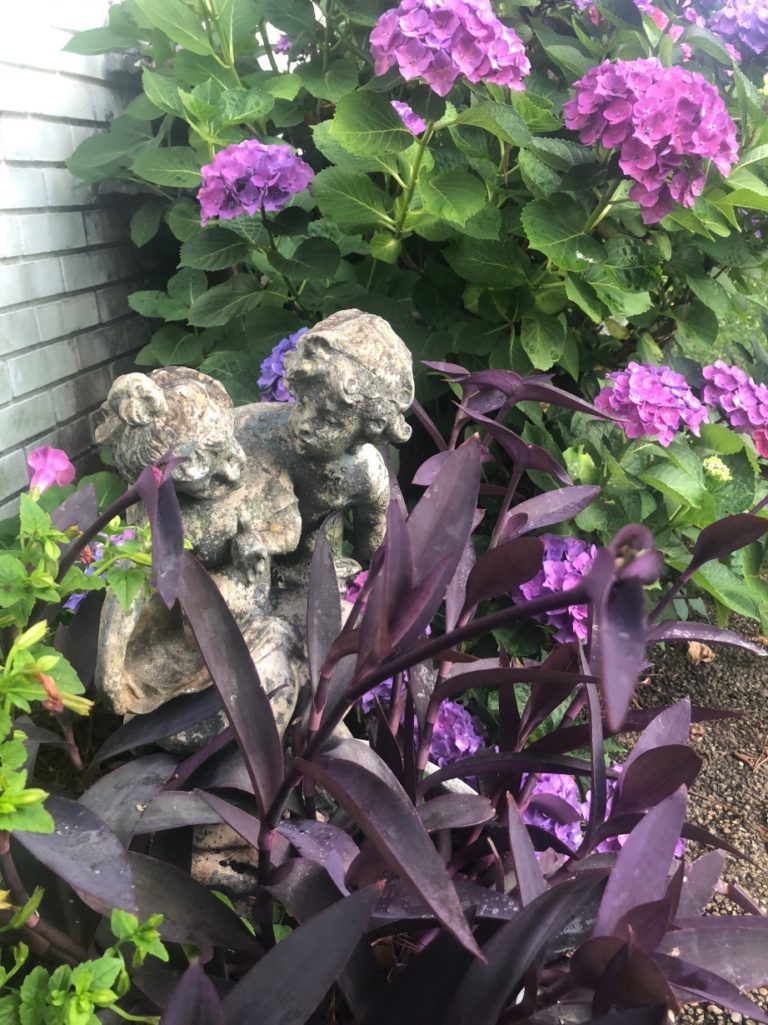
Do you have a passion for purple in the garden? You can call it Purple Heart or Purple Queen but Tradescantia pallida is a queen among plants. It has deep purple colored long leaves and the flower blooms with a light pinkish color.
It is drought hardy and a perennial. I love anything that is beautiful, isn’t high maintenance, and comes back year after year. I have grown this plant indoors and outside. It is beautiful as a single planting in a container, grouped with other plantings, or in the landscape as groundcover.

That pretty much puts the purple queen in a league of it’s own.
The 411 on purple queen
Purple queen is often referred to as a “creeping perennial” due to the fact that it will spread out as it grows. The plant will typically reach anywhere from 8 to 14 inches tall and 16 inches wide (although it can spread out about 5 feet). Purple heart is considered to have a fairly fast rate of growth, especially when compared to other indoor plants. Its flowers will die off in the winter months.

Gardeners should be aware that purple heart flowers are known to form dense groundcovers, which can prevent the germination and establishment of other plants. However, the plants can add a lush and tropical ground cover texture to any landscape. Downward trailing stems mean it will always stand out, even when planted as part of border fronts, wall plantings, and in rock gardens.
Light:
Planting your purple queen in full sun can help ensure that they grow the boldest and vibrant purple stems. The plant can also grow in partial shade, but its stem is more likely to appear green than purple.
It’s best to introduce these plants to brighter conditions over time, however, as too much direct sunlight all at once can lead to foliage burn.
These plants will grow best in soil that’s lightweight, porous, and moist. Though most commercial potting mixes will work just fine, the soil should ideally include peat moss, perlite, and compost. However, you’ll just want to be sure that there are drainage holes on the bottom of the container when planting indoors, as too much water can lead to root rot.
Water:
Purple queen is considered to be drought tolerant and it will not require a great deal of watering. For best growth, however, it is best not to let the plant sit dry for long periods.
Aim to water the plant when the top layer of soil feels dry to the touch. You’ll also want to stick to watering it during its blooming season. Keep in mind that younger plants will require more moisture than adults, and they should generally be watered at least weekly.
Temperature and Humidity:
Purple queen can survive in an array of temperatures, but it’s susceptible to frost. The average household humidity of 40 to 50 percent creates an ideal growing condition for the plant. If your house has drier air placing it in a bathroom or kitchen. Dry air will impact the leaves.
Pruning:
The plant grows long stems, and due to its fast growth rate, it can become leggy and spindly very quickly. You’ll want to prune it during the warmer months. Be sure to use sharp pruners and gloves. Aim to take off the top half of the stems that have become overgrown.
I often bring a cutting inside to leave on my kitchen window sill. They will continue to bloom if you change the water periodically and they get enough light.
Inside or out, purple queen provides beauty. If you haven’t grown it in your garden, give it a try.

